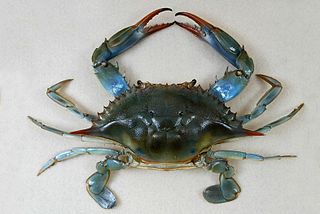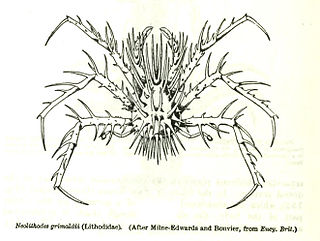 W
WOcypode africana, commonly known as the African ghost crab, is a species of ghost crabs native to the eastern Atlantic coast of western Africa, from Mauritania to Namibia. They are medium-sized ghost crabs reaching carapace width of 3.4 cm (1.3 in). They can vary in coloration from pinkish to dark grey. They are one of only two ghost crab species found in the eastern Atlantic. However, African ghost crabs can easily be distinguished from tufted ghost crabs by the absence of long tufts of hair on the tip of their eyestalks.
 W
WThe Atlantic ghost crab, Ocypode quadrata, is a species of ghost crab. It is a common species along the Atlantic coast of the United States, where it is the only species of ghost crab; its range of distribution extends from its northernmost reach on beaches in Westport, Massachusetts, south along the coasts of the tropical Western Atlantic Ocean to the beach of Barra do Chui, in Rio Grande do Sul in southern Brazil.
 W
WThe bathyal swimming crab, Bathynectes longispina, is a species of crab in the family Polybiidae.
 W
WCallinectes sapidus, the blue crab, Atlantic blue crab, or regionally as the Chesapeake blue crab, is a species of crab native to the waters of the western Atlantic Ocean and the Gulf of Mexico, and introduced internationally.
 W
WChaceon quinquedens, commonly known as the red deep-sea crab, but sold as Atlantic deep sea red crab, or simply Atlantic red crab or red crab is a crab that lives in the Atlantic Ocean off the East Coast of the United States and Canada, from North Carolina to Nova Scotia.
 W
WThe Florida stone crab is a crab found in the western North Atlantic, from Connecticut to Belize, including Texas, the Gulf of Mexico, Cuba, The Bahamas, and the East Coast of the United States. The crab can also be found in and around the salt marshes of South Carolina and Georgia. It is widely caught for food. The closely related species Menippe adina is sometimes considered a subspecies – they can interbreed, forming hybrids – and they are treated as one species for commercial fishing, with their ranges partly overlapping. The two species are believed to have diverged approximately 3 million years ago.
 W
WThe great spider crab, Hyas araneus, is a species of crab found in northeast Atlantic waters and the North Sea, usually below the tidal zone.
 W
WThe Jonah crab is a marine brachyuran crab that inhabits waters along the east coast of North America from Newfoundland to Florida. Jonah crabs possess a rounded, rough-edged carapace with small light spots, and robust claws with dark brown-black tips. The maximum reported carapace width for males is 222 mm, while females rarely exceed 150 mm. It is the closest relative to the European brown crab in the Western Atlantic.
 W
WNeolithodes agassizii is a species of king crab native to the Western Atlantic. They live at depths of 200–1,900 metres (660–6,230 ft) and have been found as far south as Rio de Janeiro, as far north as latitude 36°, and near the Equator.
 W
WNeolithodes grimaldii, the porcupine crab, is a species of king crab in the family Lithodidae. This large red crab is found in cold deep waters in the North Atlantic and often caught as a bycatch in fisheries for Greenland turbot. As suggested by its common name, the carapace and legs are covered in long spines.
 W
WThe oyster crab is a small, whitish or translucent crab in the family Pinnotheridae.
 W
WThe pea crab, Pinnotheres pisum, is a small crab in the family Pinnotheridae that lives as a parasite in oysters, clams, mussels, and other species of bivalves.
 W
WPlatyxanthus crenulatus is a species of crab in the family Platyxanthidae. The species is found along the sublittoral zone of the western Atlantic in the waters of Brazil, Uruguay and Argentina, associated mostly with hard bottoms. Adults are robust and conspicuous crabs, with a smooth carapace, dorsally purple and white ventrally. Their claws have marked heterochely and right-handedness, traits associated with shell-breaking feeding habits. Due to its abundance, large size and diet, P. crenulatus presumably has an important ecological role as a predator in benthic communities.
 W
WInachus dorsettensis, commonly known as the scorpion spider crab, is a species of crab generally found on loose substrates from 6 metres (20 ft) depth down to about 100 m (330 ft). It is found along the east coast of the Atlantic Ocean from Norway to South Africa, and also in the Mediterranean Sea.
 W
WThe thumbnail crab, Thia scutellata, is a species of crab whose carapace resembles a human thumbnail. It is found in the North Sea, north-east Atlantic and Mediterranean Sea. It is the only extant species in the genus Thia, although two fossil species are known.
 W
WThe velvet crab, or alternately velvet swimming crab, devil crab, “fighter crab”, or lady crab, Necora puber, is a species of crab. It is the largest of the swimming crab family (Portunidae) found in British coastal waters. It has a carapace width of up to 100 millimetres (3.9 in), and is the only species in the genus Necora. Its body is coated with short hairs, giving the animal a velvety texture, hence the common name. It is one of the major crab species for United Kingdom fisheries, in spite of its relatively small size.